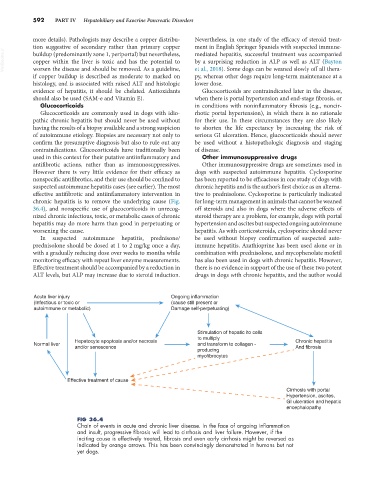Page 620 - Small Animal Internal Medicine, 6th Edition
P. 620
592 PART IV Hepatobiliary and Exocrine Pancreatic Disorders
more details). Pathologists may describe a copper distribu- Nevertheless, in one study of the efficacy of steroid treat-
tion suggestive of secondary rather than primary copper ment in English Springer Spaniels with suspected immune-
VetBooks.ir buildup (predominantly zone 1, periportal) but nevertheless, mediated hepatitis, successful treatment was accompanied
by a surprising reduction in ALP as well as ALT (Bayton
copper within the liver is toxic and has the potential to
et al., 2018). Some dogs can be weaned slowly off all thera-
worsen the disease and should be removed. As a guideline,
if copper buildup is described as moderate to marked on py, whereas other dogs require long-term maintenance at a
histology, and is associated with raised ALT and histologic lower dose.
evidence of hepatitis, it should be chelated. Antioxidants Glucocorticoids are contraindicated later in the disease,
should also be used (SAM-e and Vitamin E). when there is portal hypertension and end-stage fibrosis, or
Glucocorticoids in conditions with noninflammatory fibrosis (e.g., noncir-
Glucocorticoids are commonly used in dogs with idio- rhotic portal hypertension), in which there is no rationale
pathic chronic hepatitis but should never be used without for their use. In these circumstances they are also likely
having the results of a biopsy available and a strong suspicion to shorten the life expectancy by increasing the risk of
of autoimmune etiology. Biopsies are necessary not only to serious GI ulceration. Hence, glucocorticoids should never
confirm the presumptive diagnosis but also to rule out any be used without a histopathologic diagnosis and staging
contraindications. Glucocorticoids have traditionally been of disease.
used in this context for their putative antiinflammatory and Other immunosuppressive drugs
antifibrotic actions, rather than as immunosuppressives. Other immunosuppressive drugs are sometimes used in
However there is very little evidence for their efficacy as dogs with suspected autoimmune hepatitis. Cyclosporine
nonspecific antifibrotics, and their use should be confined to has been reported to be efficacious in one study of dogs with
suspected autoimmune hepatitis cases (see earlier). The most chronic hepatitis and is the author’s first choice as an alterna-
effective antifibrotic and antiinflammatory intervention in tive to prednisolone. Cyclosporine is particularly indicated
chronic hepatitis is to remove the underlying cause (Fig. for long-term management in animals that cannot be weaned
36.4), and nonspecific use of glucocorticoids in unrecog- off steroids and also in dogs where the adverse effects of
nized chronic infectious, toxic, or metabolic cases of chronic steroid therapy are a problem, for example, dogs with portal
hepatitis may do more harm than good in perpetuating or hypertension and ascites but suspected ongoing autoimmune
worsening the cause. hepatitis. As with corticosteroids, cyclosporine should never
In suspected autoimmune hepatitis, prednisone/ be used without biopsy confirmation of suspected auto-
prednisolone should be dosed at 1 to 2 mg/kg once a day, immune hepatitis. Azathioprine has been used alone or in
with a gradually reducing dose over weeks to months while combination with prednisolone, and mycophenolate mofetil
monitoring efficacy with repeat liver enzyme measurements. has also been used in dogs with chronic hepatitis. However,
Effective treatment should be accompanied by a reduction in there is no evidence in support of the use of these two potent
ALT levels, but ALP may increase due to steroid induction. drugs in dogs with chronic hepatitis, and the author would
Acute liver injury Ongoing inflammation
(Infectious or toxic or (cause still present or
autoimmune or metabolic) Damage self-perpetuating)
Stimulation of hepatic ito cells
to multiply
Hepatocyte apoptosis and/or necrosis Chronic hepatitis
Normal liver and transform to collagen -
and/or senescence And fibrosis
producing
myofibrocytes
Effective treatment of cause
Cirrhosis with portal
Hypertension, ascites,
GI ulceration and hepatic
encephalopathy
FIG 36.4
Chain of events in acute and chronic liver disease. In the face of ongoing inflammation
and insult, progressive fibrosis will lead to cirrhosis and liver failure. However, if the
inciting cause is effectively treated, fibrosis and even early cirrhosis might be reversed as
indicated by orange arrows. This has been convincingly demonstrated in humans but not
yet dogs.

